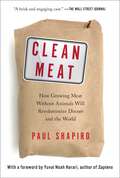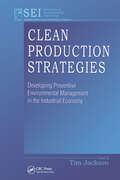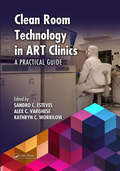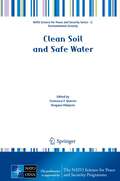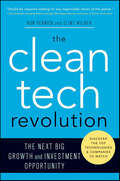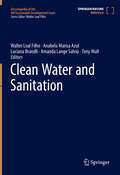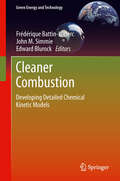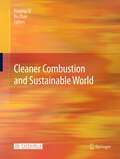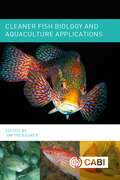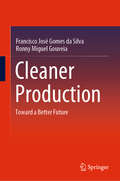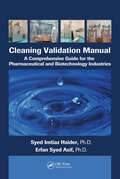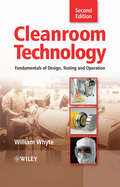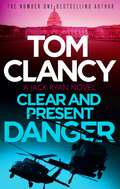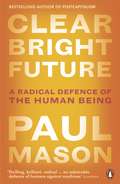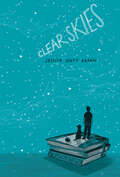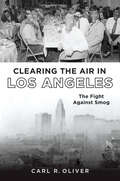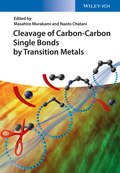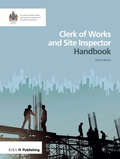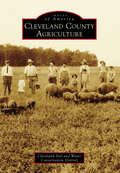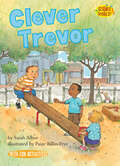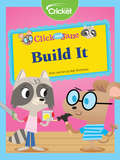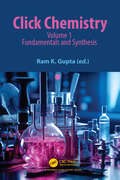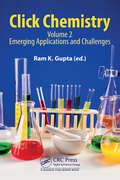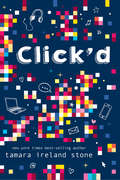- Table View
- List View
Clean Meat: How Growing Meat Without Animals Will Revolutionize Dinner and the World
by Paul ShapiroPaul Shapiro gives you a front-row seat for the wild story of the race to create and commercialize cleaner, safer, sustainable meat—real meat—without the animals. From the entrepreneurial visionaries to the scientists&’ workshops to the big business boardrooms—Shapiro details that quest for clean meat and other animal products and examines the debate raging around it.Since the dawn of Homo sapiens some quarter million years ago, animals have satiated our species&’ desire for meat. But with a growing global population and demand for meat, eggs, dairy, leather, and more, raising such massive numbers of farm animals is woefully inefficient and takes an enormous toll on the planet, public health, and certainly the animals themselves. But what if we could have our meat and eat it, too? The next great scientific revolution is underway—discovering new ways to create enough food for the world&’s ever-growing, ever-hungry population. Enter clean meat—real, actual meat grown (or brewed!) from animal cells—as well as other clean foods that ditch animal cells altogether and are simply built from the molecule up. Also called lab-grown meat, cultured meat, or cell-based meat, this race promises promise to bring about another domestication. Whereas our ancestors domesticated wild animals into livestock, today we&’re beginning to domesticate their cells, leaving the animals out of the equation. From one single cell of a cow, you could feed an entire village. And the story of this coming &“second domestication&” is anything but tame.
Clean Production Strategies Developing Preventive Environmental Management in the Industrial Economy
by Tim JacksonClean Production Strategies is a cross-disciplinary book that presents a comprehensive examination of a new ethic emphasizing the appropriate design of products, processes, and economic activities to reduce the generation of waste into the environment. The book explores concepts and principles, technological issues, economic implications, the development of policy, and broad social questions associated with implementing clean production strategies. Written by a team of international experts in the field, Clean Production Strategies covers a wide range of topics, including principles of thermodynamics, quantitative assessments of material flows, the development of practical clean technologies, and the re-evaluation of our relationship with the environment. The book will be useful to government policy-makers, industrial decision-makers, plant managers, industrial engineers, economists, environmentalists, international regulatory agency personnel, and others interested in the topic.
Clean Room Technology in ART Clinics: A Practical Guide
by Sandro C. Esteves Alex C. Varghese Kathryn C. WorrilowRegulatory agencies worldwide have issued directives or such requirements for air quality standards in embryology laboratories. This practical guide reviews the application of clean room technology or controlled environments specifically suited for Assisted Reproductive Technology (ART) Units. Its comprehensive coverage includes material on airborne particles and volatile organic compounds, including basic concepts, regulation, construction, materials, certification, clinical results in humans, and more.
Clean Soil and Safe Water (NATO Science for Peace and Security Series C: Environmental Security)
by Dragana Vidojevic Francesca F. QuerciaThis book addresses questions of relevance to governments and industry in many countries around the world, in particular concerning the link between contaminated-land-management programs and the protection of drinking water resources and the potential effects of climate changes on the availability of these same resources. On the "problem" side, it reports and analyzes methodologies and experiences in monitoring and characterization of drinking water resources (at basin, country and continental scales), pollution prevention, assessment of background quality and of impacts on safety and public health from land and water contamination and impacts of climate change. On the "solution" side, the book presents results from national cleanup programs, recent advances in research into groundwater and soil remediation techniques, treatment technologies, research needs and information sources, land and wastewater management approaches aimed at the protection of drinking water.
The Clean Tech Revolution: The Next Big Growth and Investment Opportunity
by Ron Pernick Clint WilderWhen industry giants such as GE, Toyota, and Sharp and investment firms such as Goldman Sachs are making multibillion-dollar investments in clean technology, the message is clear. Developing clean technologies is no longer a social issue championed by environmentalists; it's a moneymaking enterprise moving solidly into the business mainstream. In fact, as the economy faces unprecedented challenges from high energy prices, resource shortages, and global environmental and security threats, clean tech—technologies designed to provide superior performance at a lower cost while creating significantly less waste than conventional offerings—promises to be the next engine of economic growth.In The Clean Tech Revolution, authors Ron Pernick and Clint Wilder identify the major forces that have pushed clean tech from back-to-the-earth utopian dream to its current revolution among the inner circles of corporate boardrooms, on Wall Street trading floors, and in government offices around the globe. By highlighting eight major clean-tech sectors—solar energy, wind power, biofuels and biomaterials, green buildings, personal transportation, the smart grid, mobile applications, and water filtration—they uncover how investors, entrepreneurs, and individuals can profit from this next wave of technological innovation. Pernick and Wilder shine the spotlight on the winners among technologies, companies, and regions that are likely to reap the greatest benefits from clean tech—and they show you why the time to act is now.Groundbreaking and authoritative, The Clean Tech Revolution is the must-read book to understand and profit from the clean technologies that are reshaping our fast-changing world.
Clean Water and Sanitation (Encyclopedia of the UN Sustainable Development Goals)
by Walter Leal Filho Anabela Marisa Azul Luciana Brandli Amanda Lange Salvia Tony WallThe problems related to the process of industrialisation such as biodiversity depletion, climate change and a worsening of health and living conditions, especially but not only in developing countries, intensify. Therefore, there is an increasing need to search for integrated solutions to make development more sustainable. The United Nations has acknowledged the problem and approved the “2030 Agenda for Sustainable Development”. On 1st January 2016, the 17 Sustainable Development Goals (SDGs) of the Agenda officially came into force. These goals cover the three dimensions of sustainable development: economic growth, social inclusion and environmental protection. The Encyclopedia of the UN Sustainable Development Goals comprehensively addresses the SDGs in an integrated way. It encompasses 17 volumes, each devoted to one of the 17 SDGs. This volume is dedicated to SDG 6 "Ensure availability and sustainable management of water and sanitation for all". Water and sanitation are fundamental to human well-being. Integrated water resources management is essential to ensure availability and sustainable management of water and sanitation for all and to the realization of Sustainable Development.Concretely, the defined targets are:Achieve universal and equitable access to safe and affordable drinking water for allAchieve access to adequate and equitable sanitation and hygiene for all and end open defecation, paying special attention to the needs of women and girls and those in vulnerable situationsImprove water quality by reducing pollution, eliminating dumping and minimizing release of hazardous chemicals and materials, halving the proportion of untreated wastewater and substantially increasing recycling and safe reuse globallySubstantially increase water-use efficiency across all sectors and ensure sustainable withdrawals and supply of freshwater to address water scarcity and substantially reduce the number of people suffering from water scarcity Implement integrated water resources management at all levels, including through transboundary cooperation as appropriateProtect and restore water-related ecosystems, including mountains, forests, wetlands, rivers, aquifers and lakes Expand international cooperation and capacity-building support to developing countries in water- and sanitation-related activities and programmes, including water harvesting, desalination, water efficiency, wastewater treatment, recycling and reuse technologiesSupport and strengthen the participation of local communities in improving Uwater and sanitation managementEditorial BoardUlisses M. Azeiteiro, Anabela Marisa Azul, Luciana Brandli, Dominique Darmendrail, Despo Fatta–Kassinos, Walter Leal Filho, Susan Hegarty, Amanda Lange Salvia, Albert Llausàs, Paula Duarte Lopes, Javier Marugán, Fernando Morgado, Wilkister Nyaora Moturi, Karel F. Mulder, Alesia Dedaa Ofori, Sandra Ricart
Cleaner Combustion: Developing Detailed Chemical Kinetic Models (Green Energy and Technology)
by Edward Blurock Frédérique Battin-Leclerc John M. SimmieThis overview compiles the on-going research in Europe to enlarge and deepen the understanding of the reaction mechanisms and pathways associated with the combustion of an increased range of fuels. Focus is given to the formation of a large number of hazardous minor pollutants and the inability of current combustion models to predict the formation of minor products such as alkenes, dienes, aromatics, aldehydes and soot nano-particles which have a deleterious impact on both the environment and on human health. Cleaner Combustion describes, at a fundamental level, the reactive chemistry of minor pollutants within extensively validated detailed mechanisms for traditional fuels, but also innovative surrogates, describing the complex chemistry of new environmentally important bio-fuels. Divided into five sections, a broad yet detailed coverage of related research is provided. Beginning with the development of detailed kinetic mechanisms, chapters go on to explore techniques to obtain reliable experimental data, soot and polycyclic aromatic hydrocarbons, mechanism reduction and uncertainty analysis, and elementary reactions. This comprehensive coverage of current research provides a solid foundation for researchers, managers, policy makers and industry operators working in or developing this innovative and globally relevant field.
Cleaner Combustion and Sustainable World
by Bo Zhao Haiying QiCleaner Combustion and Sustainable World is the proceedings of the 7th International Symposium on Coal Combustion which has a significant international influence. It concerns basic research on coal combustion and clean utilization, techniques and equipments of pulverized coal combustion, techniques and equipments of fluidized bed combustion, basic research and techniques of emission control, basic research and application techniques of carbon capture and storage (CCS), etc. Professor Haiying Qi and Bo Zhao both work at the Tsinghua University, China
Cleaner Fish Biology and Aquaculture Applications
by Jim TreasurerCleaner fish are increasingly being deployed in aquaculture as a means of biological control of parasitic sea lice, and consequently the farming of wrasse and lumpfish, the main cleaner fish species in current use in salmon farming, is now one of the fastest expanding aquaculture sectors, with over 40 hatcheries in Norway alone. Cleaner Fish Biology and Aquaculture Applications reviews and presents new knowledge on the biology of the utilised cleaner fish species, and provides protocols in cleaner fish rearing, deployment, health and welfare. The latest knowledge is presented on specialist technical areas such as cleaner fish nutrition, genetics, health, immunology and vaccinology, welfare, transport and fisheries. Specific chapters detail cleaner fish developments in the main salmon-producing countries. Contributions from over 60 leading researchers and producers give an exciting mix of information and debate. The book comprehensively addresses the questions of sustainability of cleaner fish use in aquaculture, bottlenecks to the optimum production of cleaner fish, and improvements and best practice in on-farm deployment methods, for optimum survival and enhanced welfare of cleaner fish. Some of the key features of this important book: - Provides a comprehensive review of the latest globally available information on the use of cleaner fish under one cover. - Highlights and addresses the main issues in the farming of cleaner fish and provides guidance on how to improve growth and survival. - Identifies issues in the farm application of cleaner fish and provides details on how to address these issues. - Written by a team of internationally recognised experts in cleaner fish biology, culture and deployment. Cleaner Fish Biology and Aquaculture Applications is an essential purchase for hatchery managers, salmonid producers, fish farm operatives, researchers, regulators, students and enthusiasts working with, and interested in, cleaner fish. Personnel within companies supplying equipment and services to the aquaculture industry, and libraries in all universities and research establishments where biological sciences and aquaculture are studied and taught should have copies of this landmark publication.
Cleaner Production: Toward a Better Future
by Francisco José Gomes da Silva Ronny Miguel GouveiaThis book provides an overview of cleaner production, including how regulations have evolved, and presents a broad perspective on how it is being developed. Presenting several practical examples and applications of modern clean production technologies, it provides readers with ideas on how to extend these practices to other industry sectors in order to contribute to a better environment in the future.The authors start from the initial concepts of how to implement new cleaner production systems, before collecting recent developments in the area and demonstrating practical ways in which the latest knowledge can be applied. It motivates readers to develop new ideas on how to improve manufacturing systems to save energy and generate less waste, and discusses strategies on how to save, reuse and adapt materials, as well as techniques to reduce the waste and pollution produced.This book serves as a reference resource for industrial management engineers and researchers, and is also of interest to undergraduate and postgraduate students looking for insights into cleaner production in industry.
Cleaning Validation Manual: A Comprehensive Guide for the Pharmaceutical and Biotechnology Industries
by Syed Imtiaz HaiderDuring the past decades, enormous progress and enhancement of pharmaceutical manufacturing equipment and its use have been made. And while there are support documents, books, articles, and online resources available on the principles of cleaning and associated processing techniques, none of them provides a single database with convenient, ready-to-use training tools. Until now. Cleaning Validation Manual: A Comprehensive Guide for the Pharmaceutical and Biotechnology Industries elucidates how to train the man power involved in development, manufacturing, auditing, and validation of bio pharmaceuticals on a pilot scale, leading to scale-up production.With over 20 easy-to-use template protocols for cleaning validation of extensively used equipments, this book provides technical solutions to assist in fulfilling the training needs of finished pharmaceutical manufacturers. Drawing on the authors’ more than two decades of experience in the pharmaceutical and biotech industries, the text offers hands-on training based on current approaches and techniques. The book does not merely provide guidelines or thought processes, rather it gives ready-to-use formulas to develop Master Plan, SOPs, and validation protocols. It includes cleaning procedures for the most commonly used equipment in various manufacturing areas and their sampling points, using a pharmaceutical manufacturing site with both sterile and non-sterile operations as the case facility. It also provides the training guidelines on downloadable resources to enable users to amend or adopt them as necessary.Grounded in practicality, the book’s applicability and accessibility set it apart. It can be used as a guide for implementing a cleaning validation program on site without the help of external consultants, making it a resource that will not be found collecting dust on a shelf, but rather, referred to again and again.
Cleanroom Technology
by William WhyteA self-contained and practical book providing step-by-step guidance to the design and construction of cleanrooms, appropriate testing methodologies, and operation for the minimization of contamination...This second edition has been comprehensively revised and includes extensive updates to the two chapters that contain information on cleanroom standards and guidelines. The chapter on risk management has been extensively revised, especially the section on risk assessment. Other new subjects that have been added to the various chapters are those on clean-build, determination of air supply volumes for non-unidirectional airflow cleanrooms, RABS (Restricted Access Barrier Systems), contamination recovery test methods, entry of large items into a cleanroom, glove allergy problems, and how to develop a cleanroom cleaning programme.Used for in-house training and a textbook in colleges, this volume is for cleanroom personnel at all levels. It provides novices with an introduction to the state-of-the-art technology and professionals with an accessible reference to the current practices. It is particularly useful in the semiconductor, pharmaceutical, biotechnology and life sciences industries.William Whyte is an international authority in cleanrooms, with over 45 years experience in research, teaching and consulting in the electronic, healthcare and pharmaceutical industries. He is a member of British and International standards committees writing the International Cleanroom standards, and has received numerous awards for his work in Cleanroom Technology.A comment on the first edition:"...extremely useful and helpful...very well-written, highly organized, easy to understand and follow..." (Environmental Geology, 2003)
Clear and Present Danger: A classic Jack Ryan thriller from international bestseller Tom Clancy (Jack Ryan #4)
by Tom Clancy'Absorbing . . . You won't stop until you hit the last pages!' Wall Street JournalWhen Colombian drug lords assassinate both the U.S. ambassador and the visiting head of the FBI, their actions trigger a covert response from the American government - a response that goes horribly wrong . . .As the newly named Deputy Director of Intelligence for the CIA, Jack Ryan should be privy to operations like the one in Colombia, but he's been left completely in the dark. With the help of field officer John Clark, Ryan intends to find out what's really going on. But while they expect danger from without, the greatest threat of all may come from within.
Clear Bright Future: A Radical Defence of the Human Being
by Paul MasonA passionate defence of humanity and a work of radical optimism from the international bestselling author of PostcapitalismHow do we preserve what makes us human in an age of uncertainty? Are we now just consumers shaped by market forces? A sequence of DNA? A collection of base instincts? Or will we soon be supplanted by algorithms and A.I. anyway?In Clear Bright Future, Paul Mason calls for a radical, impassioned defence of the human being, our universal rights and freedoms and our power to change the world around us. Ranging from economics to Big Data, from neuroscience to the culture wars, he draws from his on-the-ground reporting from mass protests in Istanbul to riots in Washington, as well as his own childhood in an English mining community, to show how the notion of humanity has become eroded as never before.In this book Paul Mason argues that we are still capable - through language, innovation and co-operation - of shaping our future. He offers a vision of humans as more than puppets, customers or cogs in a machine. This work of radical optimism asks: Do you want to be controlled? Or do you want something better?
Clear Skies
by Jessica Scott KerrinAs the US/Soviet Space Race heats up in 1961, eleven-year-old Arno finds his dreams of becoming an astronomer exploding like an extragalactic supernova. It is the summer of 1961, and eleven-year-old Arno Creelman wants nothing more than to be an astronomer. His claustrophobia rules out flying in a cramped space capsule, so instead, Arno dreams of exploring the galaxies with powerful telescopes back on Earth. Arno’s first move: Enter a local radio contest and win a visit to the new observatory that is about to open near his town. The ribbon will be cut by Arno’s idol, Jean Slayter-Appleton, a renowned astronomer whose weekly columns Arno clips for his own notebooks. When he finally manages to phone in and correctly answer the skill-testing astronomy question, Arno is thrilled. Then a new boy moves to the neighborhood, and he seems to challenge Arno in every way. Robert even believes in astrology, which Arno argues is not a science at all. Before long, Arno is feeling left behind, on the outs with his friends and even abandoned by his beloved dog, Comet. How did Arno’s dream become a cosmic nightmare? Key Text Features illustrations Correlates to the Common Core State Standards in English Language Arts: CCSS.ELA-LITERACY.RL.4.3 Describe in depth a character, setting, or event in a story or drama, drawing on specific details in the text (e.g., a character's thoughts, words, or actions).
Cleared for Takeoff: The Ultimate Book of Flight
by Rowland WhiteAll of aviation's dangerous, exciting, and most courageous moments are featured within this stunning compendium on flight. Packed with stories of heroic and innovative pioneers, fascinating profiles of remarkable planes from Spitfires to space shuttles, and how-to instructions for making everything from origami helicopters to bottle rockets—all accompanied by sensational photographs, illustrations, and diagrams—Cleared for Takeoff promises to astonish, entertain, and fire the imaginations of everyone with their head in the clouds.
Clearing the Air in Los Angeles: The Fight Against Smog (Narrative)
by Carl R. OliverSolving the mystery of California's most persistent smog.Once known as the Smog Capital of the World, Los Angeles has changed "air you can see " into "air you can breathe ." While the fight to eliminate pollution in the city continues, modern smog is not the thick, oppressive, silver-blue haze that drove people to move out of Los Angeles altogether during the mid-twentieth century. Professor Arie Haagen-Smit became a key leader in the fight against smog after making a crucial discovery--what caused it. Join author Carl R. Oliver as he delves into the sixty-year battle to clear the air in Los Angeles.
Cleavage of Carbon-Carbon Single Bonds by Transition Metals
by Masahiro Murakami Naoto ChataniEdited by leading experts and pioneers in the field, this is the first up-to-date book on this hot topic. The authors provide synthetic chemists with different methods to activate carbon-carbon sigma bonds in organic molecules promoted by transition metal complexes. They explain the basic principles and strategies for carbon-carbon bond cleavage and highlight recently developed synthetic protocols based on this methodology. In so doing, they cover cleavage of C-C bonds in strained molecules, reactions involving elimination of carbon dioxide and ketones, reactions via retroallylation, and cleavage of C-C bonds of ketones and nitriles. The result is an excellent information source for researchers in academia and industry working in the field of synthetic organic chemistry, while equally serving as supplementary reading for advanced courses in organometallic chemistry and catalysis.
Clerk of Works and Site Inspector Handbook: 2018 Edition
by The Institute of Clerks of Works and Construction InspectorateThis new edition of the popular handbook is a practical companion for Clerks of Works, Site Inspectors and anyone with the responsibility of managing construction works on site. Clerk of Works and Site Inspector Handbook, 2018 edition the book explains the traditional site inspector/clerk of works role and their liabilities, as well as duties and responsibilities linked to a more contemporary construction setting. It explores the relationship between inspectors, architects and other construction professionals, whilst providing valuable insight into reporting and what to look for, check and test every step of the way. It's an essential reference book for Clerks of Works and Site Inspectors, containing important lessons for newly qualified architects, those who carry out site inspections or act as resident site architects and Part 3 students.
Cleveland County Agriculture (Images of America)
by Cleveland Soil and Water Conservation DistrictNestled in the foothills of the Blue Ridge Mountains in southwestern North Carolina, Cleveland County has long been cultivated. Before the Civil War, self-reliant farms grew and raised a diverse array of vegetables, field crops, and livestock. These small farms relied on family labor, draft animals, waterwheels, and ingenuity. Eventually, the county became a leader in production of cotton and dairy products; tractors, combines, and hay balers became farm mainstays. Cleveland County Agriculture showcases the triumphs and trials of farmers--farmers who endured the Great Depression, the arrival of the boll weevil, and the everyday challenges of farm life.
Clever Trevor (Science Solves It!)
by Sarah AlbeeSolve kid-sized dilemmas and mysteries with the Science Solves It! series. These fun books for kids ages 5–8 blend clever stories with real-life science. Why did the dog turn green? Can you control a hiccup? Is that a UFO? Find the answers to these questions and more as kid characters dive into physical, life, and earth sciences. Buzz and his band of bullies have taken over the playground where Trevor and his friends hang out. But Trevor learns just enough about levers to challenge Buzz to a contest - and win! Books in this perfect STEM series will help kids think like scientists and get ahead in the classroom. Activities and experiments are included in every book! (Level Two; Science topic: Levers)
Click and Jane: Build It
by Rob McClurkanClick and Jane’s clubhouse is a mess! Follow along as they think of some fun craft projects to clean it up with the rest of the gang and learn things about building and measuring with different tools, like a hammer and a saw!
Click Chemistry: Volume 1: Fundamentals and Synthesis
by Ram K. GuptaClick chemistry involves highly efficient, reliable, and stereoselective reactions that can synthesize new materials cost-effectively. The first volume entitled “Click Chemistry: Fundamentals and Synthesis” covers the fundamentals, mechanisms, kinetics, and various approaches to synthesizing new materials making it suitable for synthetic chemists and researchers working in nanoscience and technology. The main objective of this book is to provide information about current, state-of-the-art development in click chemistry as well as challenges. Experts from around the world have contributed towards this book, making this a suitable textbook for students and providing new guidelines to researchers and industries working in these areas.
Click Chemistry: Volume 2: Emerging Applications and Challenges
by Ram K. GuptaThe primary goal of this book is to comprehensively explore the evolving applications and challenges of click chemistry. Unlike existing literature, this volume spans the entire spectrum of click chemistry—from foundational principles to cutting-edge applications across diverse fields. Each chapter, authored by leading professionals in the field, addresses emerging applications, challenges, and potential solutions in click chemistry. Designed as an essential textbook, it caters to students and researchers alike, offering fresh insights and opportunities in this rapidly advancing discipline.
Click'd (Click'd #1)
by Tamara Ireland StoneAllie Navarro can't wait to show her best friends the app she built at CodeGirls summer camp. Click'd pairs users based on common interests and sends them on a fun (and occasionally rule-breaking) scavenger hunt to find each other. And it's a hit. By the second day of school, everyone is talking about Click'd.Watching her app go viral is amazing. Leaderboards are filling up! Everyone's making new friends. And with all the data Allie is collecting, she has an even better shot at beating her archenemy, Nathan, at the upcoming youth coding competition. But when Allie discovers a glitch that threatens to expose everyone's secrets, she has to figure out how to make things right, even if that means sharing the computer lab with Nathan. Can Allie fix her app, stop it from doing any more damage, and win back the friends it hurt-all before she steps on stage to present Click'd to the judges?New York Times best-selling author Tamara Ireland Stone combines friendship, coding, and lots of popcorn in her fun and empowering middle-grade debut.
